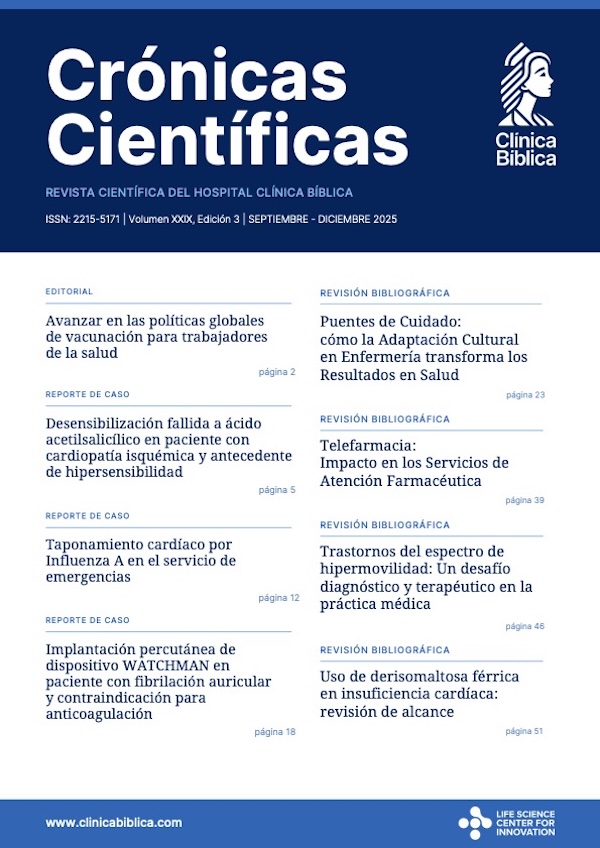- Visto: 1017
Revisión Bibliográfica
Abordaje ambulatorio en atención primaria de la Cistitis no complicada en adultas mayores
Outpatient approach in primary care for non complicated cystitis in elderly women
Edición XVI Setiembre - Diciembre 2020
DOI: https://doi.org/10.55139/PYYY8468
APA (7ª edición)
Guadamuz Hernández, S., & Suárez Brenes, G. (2020). Abordaje ambulatorio en atención primaria de la Cistitis no complicada en adultas mayores. Crónicas científicas, 16(16), 52-63. https://doi.org/10.55139/PYYY8468.
Vancouver
Martínez-Vásquez J, Picado-Loaiza S, Mora-Barrantes S. Estado Nutricional del Guadamuz Hernández S, Suárez Brenes G. Abordaje ambulatorio en atención primaria de la Cistitis no complicada en adultas mayores. Cron cient. 11 de agosto 2020; 16(16): 52-63.
Dra. Sylvia Guadamuz Hernández
Médico y cirujano. Universidad de Costa Rica.
Investigadora Independiente.
Miembro del Colegio de Médicos y Cirujanos de Costa Rica.
Dr. Gabriel Suárez Brenes
Médico y cirujano. Universidad de Costa Rica.
Investigador Independiente.
Miembro del Colegio de Médicos y Cirujanos de Costa Rica.
Resumen
En las últimas décadas, la población adulta mayor ha venido en aumento debido a los avances médicos y, con ello, han incrementado también las comorbilidades. Las infecciones del tracto urinario (ITU) ocupan el segundo lugar en las infecciones desarrolladas en adultos mayores. Al abordar una ITU, el primer paso es reconocer si se trata de una infección simple o complicada; en segunda instancia, realizar los exámenes pertinentes al caso; en tercera instancia, determinar la necesidad de un tratamiento sintomático o antibiótico; y en cuarta instancia, en caso de ser necesario, seleccionar el antibiótico más adecuado dependiendo del perfil del paciente y del patrón de resistencia presente en el medio. En la presente revisión, se estudiarán los conceptos de cistitis no complicada en la población femenina adulta mayor, la fisiopatología de la ITU, su diagnóstico, las opciones de tratamiento ambulatorio oral, así como algunas formas de prevención y pronóstico.
Palabras claves
Cistitis, disuria, infección, nitritos, bacteriuria asintomática.
Abstract
In recent decades the elderly population has been increasing thanks to medical advances and with it comorbidities have also increased. Urinary tract infections (UTIs) occupy the second place in infections developed in older adults. When addressing an UTI, the first step is to recognize whether it is a simple or complicated infection; in second instance, carry out the pertinent tests; in third instance, determine the need for symptomatic and/or antibiotic treatment; and in the fourth instance, if necessary, select the most appropriate antibiotic, specific to the patient's characteristics and to the resistance pattern present in the background. In this review we will study the concepts of uncomplicated cystitis in the elderly female population, the pathophysiology of the UTI, its diagnosis, oral outpatient treatment options, as well as some forms of prevention and its prognosis.
Keywords
Cystitis, disuria, infection, nitrites, asymptomatic bacteriuria.
Bibliografía
Alvarez, J., Iregui, J., Diaz, D., Cardenas, A., Chavarriaga, J. y Godoy, M. (2018). Guía de práctica clínica de infección de vías urinarias en el adulto. Urología Colombiana, 27, 126-131.
Caretto, M., Giannini, A., Russo, E. y Simoncini, T. (2017). Preventing urinary tract infections after menopause without antibiotics. Maturitas, 99, 43-46.
Córdoba, G., Holm, A., Hansen, F., Hammerum, A. y Bjerrum, L. (2017). Prevalence of antimicrobial resistant Escherichia coli from patients with suspected urinary tract infection in primary care, Denmark. BMC Infectious Diseases. doi 10.1186/s12879-017-2785-y
Cortes, N., Trautner, B. y Jump, R. (2017). Urinary Tract Infection and Asymptomatic Bacteriuria in Older Adults. Infectious disease clinics of North America, 31(4), 673-688.
Detweiler, K., Mayers, D. y Fletcher, S. (2015). Bacteriuria and Urinary Tract Infections in the Elderly. The Urologic clinics of North America, 42(4), 561-568.
Fekete, T. y Hooton, T. (2019). Asymptomatic bacteriuria in adults. Post TW, Calderwood, S. (ed.) UpToDate. Waltham, MA: UpToDate Inc. Recuperado el 21 de noviembre de 2019, desde https://www.uptodate.com/contents/asymptomatic-bacteriuria-in-adults
Gharbi, M., Drysdale, J., Lishman, H., Goudie, R., Molokhia, M., Johnson, A. Holmes, A., Aylin, P. (2019). Antibiotic management of urinary tract infection in elderly patients in primary care and its association with bloodstream infections and all cause mortality: population based cohort study. British Medical Journal. doi: 10.1136/bmj.l525: 10.1136/bmj.l525
Girard, R., Gaujard, S., Pergay, V., Pornon, P., Martin, G. y Bourguignon, L. (2017). Risk factors for urinary tract infections in geriatric hospitals. Journal of Hospital Infection, 97(1), 74-78.
Hooton, T. y Gupta, K. (2019). Acute simple cystitis in women. Post TW, Calderwood, S. (ed.) UpToDate. Waltham, MA: UpToDate Inc. Recuperado el 21 de noviembre de 2019, desde https://www.uptodate.com/contents/acute-simple-cystitis-in-women
Hussain, M., Berger, M., Eckenhoff, R. y Seitz, D. (2014). General anesthetic and the risk of dementia in elderly patients: current insights. Clinical interventions in aging , 9, 1619-1628.
Jiménez, J.P., Carballo, K. y Chacón, N. (2017). Manejo de infecciones del tracto urinario. Revista Costarricense de Salud Pública, 26(1), 1-10.
Long, B. y Koyfman, A. (2018). The Emergency Department Diagnosis and Management of Urinary Tract Infection. Emergency medicine clinics of North America, 36, 685-710.
Masajtis-Zagajewska, A. y Nowicki, M. (2017). New markers of urinary tract infection. Clinica Chimica Acta, 471, 286-291.
Mody, L. (2019) Approach to infection in the older adult. Post TW. Schmader, K. (ed.) UpToDate. Waltham, MA: UpToDate Inc. Recuperado el 21 de noviembre de 2019, desde https://www.uptodate.com/contents/approach-to-infection-in-the-older-adult
Nicolle, L. (2009). Ur
Nicolle, L. (2009). Urinary Tract Infections in the Elderly. Clinics in geriatric medicine, 25(3), 423-436.
Nicolle, L. (2016). Urinary Tract Infections in the Older Adult. Clinics in geriatric medicine, 32(3), 523-528.
Oyaert, M., Van Meensel, B., Cartuyvels, R., Frans, J., Laffut, W., Vandecandelaere, P., Beenhouwer, H., BILULU Study Group (2018). Laboratory diagnosis of urinary tract infections: Towards a BILULU consensus guideline. Journal of Microbiological Methods, 146, 92-99.
Robinson, D., Giarenis, I. y Cardozo, L. (2015). The management of urinary tract infections in octogenarian women. Maturitas. http://dx.doi.org/10.1016/j.maturitas.2015.04.014
Rowe, T. y Juthani-Metha, M. (2014). Diagnosis and Management of Urinary Tract Infection in Older Adults. Infectious disease clinics of North America, 28(1), 75-89.
Rowe, T., Juthani-Mehta, M. (2017). Urinary Tract Infections. En Hazzard´s Geriatric Medicine and Gerontology. (7th ed.) (pp. 2355-2371). Editores: Halter, J., Ouslander, J., Tinetti, M., Studenski, S., High, K., Asthana, S., Supiano, M., Ritchie, C. McGraw-Hill. New York, USA.
Schulz, L., Hoffman, R., Pothof, J. y Fox, B. (2016). Top ten myths regarding the diagnosis and treatment of urinary tract infections. The Journal of Emergency Medicine, 51(1), 25-30.
Sheerin, N. y Glover, E. (2019). Urinary tract infection. Medicine, 47(9), 546-550.
Smelov, V., Naber, K. y Bjerklund, T. (2016). Improved Classification of Urinary Tract Infection: Future Considerations. European Urology Supplements, 15, 71-80.
Soler, P. y Rodríguez, L. (2015). El anciano obeso. En Tratado de Medicina Geriátrica: Fundamentos de atención sanitaria a los adultos mayores (pp. 583-595). Barcelona: Elsevier.
Stalenhoef, J., van Dissel, J. y van Nieuwkoop, C. (2015). Febrile urinary tract infection in the emergency room. Current Opinion in Infectious Diseases, 28,106-111.
Tan, C. y Chlebicki, M. (2016). Urinary tract infections in adults. Singapore medical journal, 57(9), 485-490.
APA (7ª edición)
Guadamuz Hernández, S., & Suárez Brenes, G. (2020). Abordaje ambulatorio en atención primaria de la Cistitis no complicada en adultas mayores. Crónicas científicas, 16(16), 52-63. https://doi.org/10.55139/PYYY8468.
Vancouver
Martínez-Vásquez J, Picado-Loaiza S, Mora-Barrantes S. Estado Nutricional del Guadamuz Hernández S, Suárez Brenes G. Abordaje ambulatorio en atención primaria de la Cistitis no complicada en adultas mayores. Cron cient. 11 de agosto 2020; 16(16): 52-63.
Esta obra está bajo una licencia internacional Creative Commons: Atribución-NoComercial-CompartirIgual 4.0 Internacional (CC BY-NC-SA 4.0)

Realizar búsqueda
Última Edición
Ediciones Anteriores






